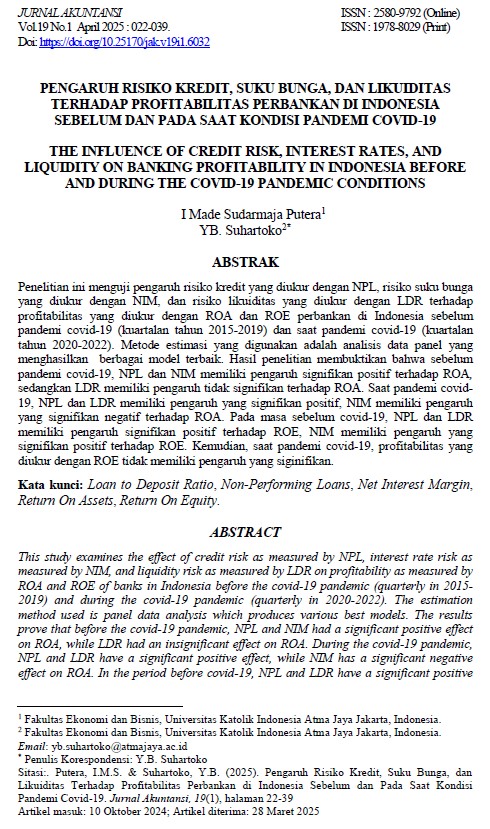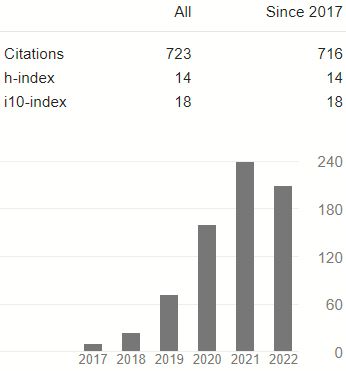THE INFLUENCE OF CREDIT RISK, INTEREST RATES, AND LIQUIDITY ON BANKING PROFITABILITY IN INDONESIA BEFORE AND DURING THE COVID-19 PANDEMIC CONDITIONS
DOI:
https://doi.org/10.25170/jak.v19i1.6032Keywords:
Loan to Deposit Ratio, Non-Performing Loans, Net Interest Margin, Return On Assets, Return On EquityAbstract
The banking industry in Indonesia is one of the backbones of the economy which has an intermediation function, namely channeling funds collected from the public in the form of savings and distributing loans or credits to the real business sector in efforts to develop businesses. This research aims to determine the effect of credit risk as measured by Non Performing Loans (NPL), interest rate risk as measured by Net Interest Margin (NIM) and liquidity risk as measured by Loan to Deposit Ratio (LDR) on profitability as measured by Return On Assets (ROA) and Return On Equity (ROE) of banking, especially Bank Group Based on Core Capital (KBMI) 4 in Indonesia before the Covid-19 pandemic (quarterly period 2015-2019) and during the Covid-19 pandemic (quarterly period 2020-2022). The data analysis method used in this research uses panel data analysis, Random Effect Model (REM) using the Eviews version 12 statistical program. The results of the analysis in this study show that credit risk as measured by NPL has a significant positive influence on profitability as measured by ROA, interest rate risk as measured by NIM has a significant positive influence on profitability as measured by ROA, liquidity risk as measured by LDR has an insignificant influence. on profitability as measured by ROA and during the 2020-2022 Covid-19 pandemic, changes in profitability as measured by ROA had an insignificant influence, credit risk as measured by NPL had a significant positive influence, interest rate risk as measured by NIM had an influence which is not significantly negative, liquidity risk as measured by LDR has a significantly positive effect. Then credit risk as measured by NPL has an insignificant positive effect on profitability as measured by ROE, interest rate risk as measured by NIM has a significant positive effect on profitability as measured by ROE, liquidity risk as measured by LDR has a significant positive effect on profitability as measured with ROE and during the 2020-2022 Covid-19 pandemic, profitability as measured by ROE had an insignificant influence.
Keywords: NPL, NIM, LDR, ROA, ROE, KBMI, Covid-19 pandemic, credit risk, interest rate risk, liquidity risk.
References
Afifah, S. S., Dharmawan, K., & Srinadi, I. G. A. M. (2022). Perhitungan risiko kredit KPR pada Bank XYZ menggunakan metode CreditRisk+. E-Jurnal Matematika, 11(2), 94. https://doi.org/10.24843/mtk.2022.v11.i02.p366
Almarzoqi, R., Naceur, S. Ben, & Scopelliti, A. D. (2015). How Does Bank Competition Affect Solvency, Liquidity and Credit Risk? Evidence from the MENA Countries. https://www.imf.org/external/pubs/ft/wp/2015/wp15210.pdf
Ariwidanta, K. T. (2016). Pengaruh risiko kredit terhadap profitabilitas dengan kecukupan modal sebagai variabel mediasi. E-Journal Manajemen Unud, 5(4), 2311–2340.
Mosey, A. C., Tommy, P., & Untu, V. N. (2018). Pengaruh Risiko Pasar Dan Risiko Kredit Terhadap Profitabilitas Pada Bank Umum Bumn Yang Terdaftar Di Bei Periode 2012-2016. Jurnal EMBA: Jurnal Riset Ekonomi, Manajemen, Bisnis Dan Akuntansi, 6(3).
Otoritas Jasa Keuangan Republik Indonesia. (2016). Salinan Peraturan Otoritas Jasa Keuangan Nomor 18 /POJK.03/2016 tentang penerapan manajemen risiko bagi bank umum.
Otoritas Jasa Keuangan Republik Indonesia. (2020a). Perubahan atas Peraturan Otoritas Jasa Keuangan Nomor 11/POJK.03/2020 tentang stimulus perekonomian nasional sebagai kebijakan countercyclical dampak penyebaran Coronavirus Disease 2019.
Otoritas Jasa Keuangan Republik Indonesia. (2020b). Salinan Peraturan Otoritas Jasa Keuangan Republik Indonesia Nomor 11/POJK.03/2020 tentang stimulus perekonomian nasional sebagai kebijakan countercyclical dampak penyebaran Coronavirus Disease 2019.
Otoritas Jasa Keuangan Republik Indonesia. (2021). Salinan Peraturan Otoritas Jasa Keuangan Republik Indonesia Nomor 12/POJK.03/2021 tentang bank umum.
Tehresia, S., Mesrawati, M., Dewi, M., Wijaya, E. Y., & Billyandi, C. (2021). Pengaruh Risiko Kredit, Risiko Likuiditas, Risiko Pasar, Dan Risiko Operasional Terhadap Profitabilitas Pada Perusahaan Sektor Perbankan. Syntax Literate; Jurnal Ilmiah Indonesia, 6(9), 4717-4730.
Putri, J. Y., & Gandakusuma, I. (2022). Analisis Pengaruh Risiko Kredit, Risiko Likuiditas, serta Risiko Operasional Terhadap Kinerja Perbankan: Studi Kasus pada Bank Umum Konvensional yang Terdaftar di Bursa Efek Indonesia Periode 2016-2020. Dalam Jurnal Manajemen dan Usahawan Indonesia, vol. 46 (1): 34-48. https://doi.org/10.7454/jmui.v46i1.1056
Saleh, I., & Abu Afifa, M. (2020). The effect of credit risk, liquidity risk and bank capital on bank profitability: Evidence from an emerging market. Cogent Economics and Finance, 8(1):1-13. https://doi.org/10.1080/23322039.2020.1814509

Downloads
Published
Issue
Section
License
Copyright (c) 2025 I Made Sudarmaja Putera Made, Yohanes Berchman Suhartoko

This work is licensed under a Creative Commons Attribution-ShareAlike 4.0 International License.
Authors who publish with this journal agree to the following terms:
- Authors retain copyright and grant the journal right of first publication with the work simultaneously licensed under a Creative Commons Attribution-ShareAlike 4.0 International License that allows others to share the work with an acknowledgment of the work's authorship and initial publication in this journal.
- Authors are able to enter into separate, additional contractual arrangements for the non-exclusive distribution of the journal's published version of the work (e.g., post it to an institutional repository or publish it in a book), with an acknowledgment of its initial publication in this journal.
- Authors are permitted and encouraged to post their work online (e.g., in institutional repositories or on their website) prior to and during the submission process, as it can lead to productive exchanges, as well as earlier and greater citation of published work.














